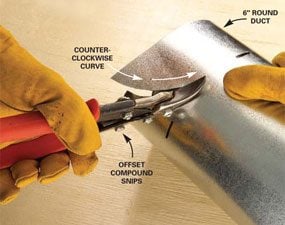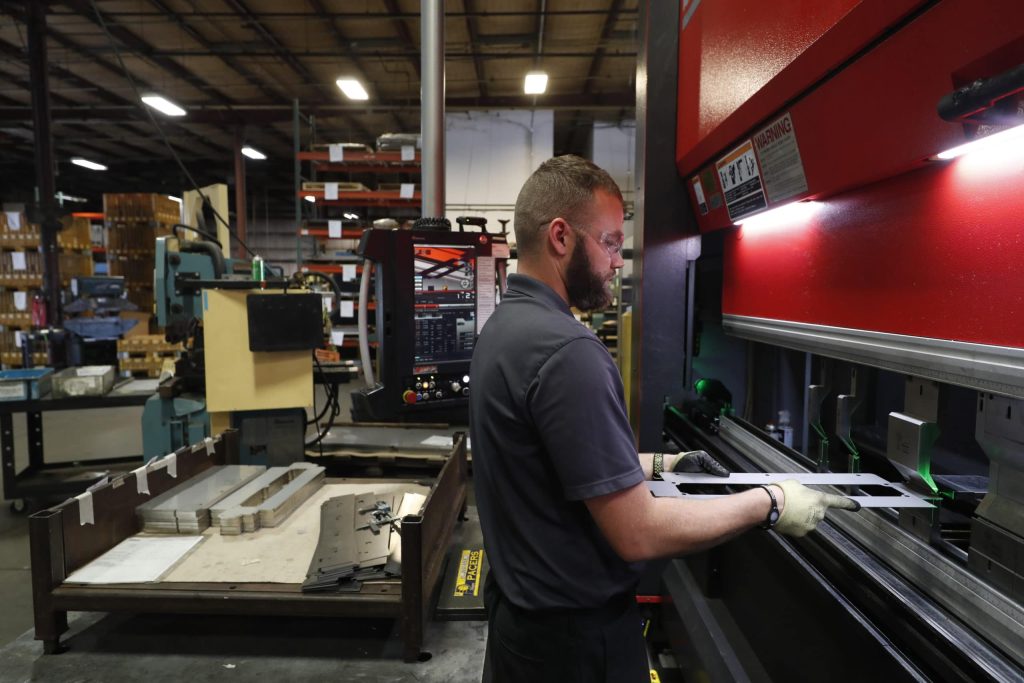Table of Contents
Cutting sheet metal can be a daunting task, especially if you don’t have the right tools or experience. However, with the right technique and a good pair of snips, you can make precise cuts on a variety of metals without breaking a sweat. In this article, we’ll take a closer look at how to cut sheet metal with snips and provide you with some useful tips and tricks to get the job done right. So, grab your snips and let’s get started!
Whether you’re a DIY enthusiast or a professional metalworker, having a good set of snips in your toolbox is essential. With the ability to cut through thin and thick sheets of metal, snips are versatile and easy to use. However, choosing the right type of snips and using them correctly can make all the difference when it comes to achieving clean and accurate cuts. In the following sections, we’ll cover everything you need to know about cutting sheet metal with snips, from selecting the right snips for the job to mastering the proper cutting technique.
- Choose the right snips for the job. Straight-cut snips are best for long, straight cuts, while duckbill snips are ideal for cutting curves.
- Mark the metal sheet with a pen or marker where you want to make your cut.
- Secure the sheet metal to your work surface with clamps or a vice to prevent it from moving while you cut.
- Position the snips at the beginning of your marked line and make the first cut. Use smooth, even pressure to cut through the metal.
- Continue cutting along your marked line, using the snips to create a straight or curved cut. Be sure to keep your hands and fingers away from the blades.
- Once you’ve made your cut, use a metal file or sandpaper to smooth any rough edges.
**How to Cut Sheet Metal With Snips?**
Sheet metal is an incredibly versatile material used in a wide range of applications, from construction and manufacturing to art and jewelry making. However, cutting through sheet metal can be a tricky task, particularly if you don’t have access to specialized cutting tools. Thankfully, there is a simple solution – snips. In this article, we’ll explore how to cut sheet metal with snips, from choosing the right tool to mastering the technique.
**1. Choose the Right Snips**
The first step in cutting sheet metal with snips is to choose the right tool. Snips come in a variety of shapes and sizes, each designed for a specific purpose. The three main types of snips are straight-cut, left-cut, and right-cut snips. Straight-cut snips are ideal for making long, straight cuts, while left-cut and right-cut snips are designed for making curved cuts in either direction.
When choosing snips, look for a pair that feels comfortable in your hand and has sharp, durable blades. A good pair of snips should be able to cut through sheet metal cleanly and easily without leaving jagged edges.
**2. Prepare the Sheet Metal**
Before you begin cutting, it’s important to prepare the sheet metal properly. Begin by measuring and marking the area you want to cut using a ruler and a marker or scribe. This will help you to make accurate cuts and avoid mistakes. Next, use a straight edge or a square to draw a cutting line along your marks. This will serve as a guide for your snips.
If you’re cutting a large piece of sheet metal, it’s a good idea to clamp it securely to a workbench or table to prevent it from moving during the cutting process.
**3. Begin Cutting**
To begin cutting, position your snips along the cutting line with the top blade on the waste side of the metal. Squeeze the handles of the snips together firmly to make the first cut. Continue cutting along the line, using short, smooth strokes to keep the snips moving smoothly. If you’re cutting a curved line, pivot the snips as you go to follow the curve.
It’s important to apply even pressure to the snips as you cut to prevent them from slipping or veering off course. Additionally, be sure to keep your fingers clear of the cutting blades to avoid injury.
**4. Make Small Cuts**
If you’re cutting a complex shape or pattern, it’s a good idea to make small cuts rather than trying to cut the entire shape in one go. This will give you greater control over the cutting process and help you to avoid mistakes. If you need to make a sharp turn or change direction, stop cutting and reposition the snips as necessary.
**5. Finish the Cut**
Once you’ve made your way along the cutting line, you’ll need to finish the cut. To do this, use your snips to nibble away at any remaining scrap metal until the cut is complete. Be sure to cut slowly and carefully to avoid damaging the metal or leaving jagged edges.
**6. Clean Up Edges**
After you’ve finished cutting, you may notice some rough or jagged edges on the sheet metal. To clean up these edges, use a metal file or sandpaper to smooth them down. This will give your sheet metal a clean, professional finish.
**7. Benefits of Cutting Sheet Metal With Snips**
There are several benefits to cutting sheet metal with snips. Firstly, snips are an affordable and accessible tool, making them a great option for DIYers or those on a tight budget. Additionally, snips are easy to use and require no special training or expertise. Finally, snips offer a high degree of precision and control, allowing you to make accurate cuts with minimal effort.
**8. Vs. Other Cutting Tools**
While snips are a great option for cutting sheet metal, they may not be the best choice for every project. For example, if you need to make long, straight cuts, a power saw or plasma cutter may be a better option. Similarly, if you’re working with thicker or harder metals, you may need to use a specialized cutting tool such as a nibbler or shears.
**9. Tips for Cutting Sheet Metal with Snips**
To get the best results when cutting sheet metal with snips, there are a few tips and tricks to keep in mind. Firstly, always choose the right type of snips for the job. Secondly, prepare your sheet metal properly before cutting to ensure accuracy and prevent mistakes. Thirdly, make small cuts and take your time to avoid errors. Finally, clean up any rough edges after cutting to give your sheet metal a professional finish.
**10. Conclusion**
Cutting sheet metal with snips is a simple and effective way to achieve precise cuts without the need for specialized tools or training. By choosing the right type of snips, preparing your sheet metal properly, and following a few key tips and tricks, you can master the technique of cutting sheet metal with snips and achieve professional-quality results every time.
Frequently Asked Questions
Here are some frequently asked questions about cutting sheet metal with snips:
What are snips and how do they differ from other cutting tools?
Snips are handheld cutting tools used for cutting sheet metal. They differ from other cutting tools like scissors or wire cutters in that they have longer blades and are specifically designed for cutting through thicker, harder materials like metal. Snips come in different varieties for different types of cuts and thicknesses of metal.
The three main types of snips are straight-cut, left-cut, and right-cut. Straight-cut snips are used for making straight cuts, while left-cut and right-cut snips are used for cutting curves to the left or right, respectively. It’s important to use the right type of snips for the job to ensure clean, precise cuts.
What safety precautions should I take when using snips?
Cutting sheet metal with snips can be dangerous if proper safety precautions are not taken. Always wear protective gloves and eye goggles to protect your hands and eyes from sharp metal fragments. Make sure your work surface is stable and secure to prevent slipping or movement while cutting.
When cutting, keep your fingers and other body parts clear of the blades to avoid injury. Take breaks as needed to prevent fatigue, and avoid using snips in wet or damp conditions to reduce the risk of slipping or electrocution.
What techniques should I use for cutting sheet metal with snips?
Before cutting, mark the sheet metal with a straight edge or template to ensure precise cuts. Start by making small, shallow cuts to guide the snips along the marked line. Use long, smooth strokes to cut through the metal, being careful not to bend or warp the sheet.
For curved cuts, use the appropriate type of snips for the direction and angle of the curve. Cut slowly and carefully, adjusting your grip and the angle of the snips as needed to maintain control. When finished cutting, use a metal file or sandpaper to smooth any rough edges or burrs.
What types of sheet metal can be cut with snips?
Snips can be used to cut a variety of sheet metals including aluminum, brass, copper, and steel. The thickness of the metal will determine the type of snips needed for the job. Straight-cut snips are best for thinner metals, while left and right-cut snips are better for thicker, harder metals.
When cutting sheet metal with snips, it’s important to use the appropriate type of snips for the thickness and type of metal being cut to ensure clean, precise cuts and to prevent damage to the snips.
What maintenance should I perform on my snips?
Proper maintenance is important to keep snips in good working condition and to prevent damage or wear. After each use, wipe the blades clean and dry to prevent rust or corrosion. If the blades become dull or damaged, sharpen or replace them as needed.
Store snips in a dry, secure location to prevent damage or loss. Avoid dropping or hitting the blades against hard surfaces, as this can cause chips or fractures in the metal. With proper care and maintenance, snips can last for years and provide clean, precise cuts for all your sheet metal projects.
In conclusion, cutting sheet metal with snips can be a challenging task, but with the right tools and techniques, it can be done with ease. It is important to choose the right type of snips for the job and to ensure they are sharp and in good condition. Additionally, maintaining a steady hand and using proper safety precautions can help ensure a successful and safe cutting experience.
Remember, practice makes perfect when it comes to cutting sheet metal with snips. Don’t be discouraged if it doesn’t come naturally at first. With patience and persistence, you can develop the skills needed to make precise and clean cuts.
Lastly, it is important to take care of your tools and keep them in good condition. Regularly cleaning and sharpening your snips can help prolong their lifespan and ensure they are always ready for use. By following these tips and techniques, cutting sheet metal with snips can be a manageable and even enjoyable task.
Request a quote today!
[contact-form-7 id="1578" title="Contact form"]
Please compress the file into a ZIP or RAR file before uploading. Alternatively, send through your RFQ by email.
enquires@unitymanufacture.com




